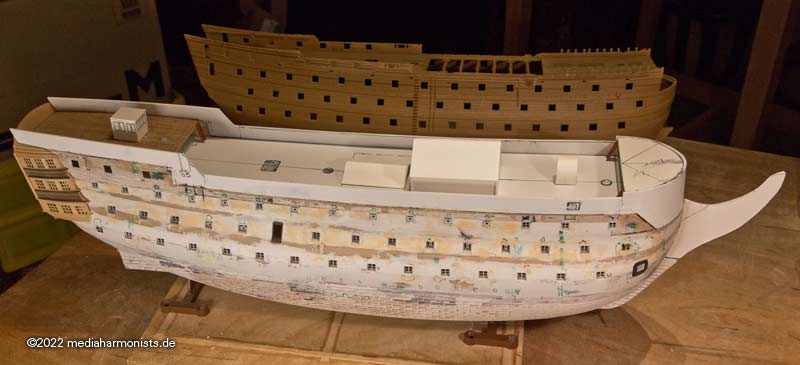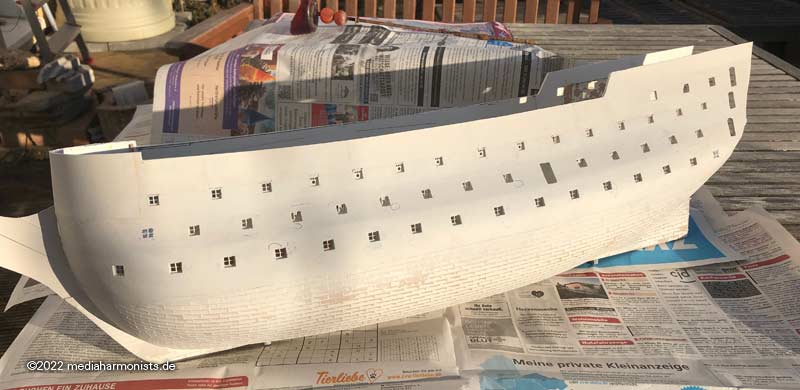Well, and the little fat one with the stripes is still stuck in the camper van since Evian. Nevertheless, there is always enough Victory for me to do.
I really missed the 1910 model at the last two exhibitions, as I like to show the developments on the ship. Time to take another look at my victorian black and white beauty. The first construction phase was January to March 2022, so that's already 2 years ago.
A brief look back: After sanding down and fattening up the entire side of the ship to get a level surface, she looked all tattered at first.

But the grace of the paint brought back some decency and dignity.

But in this state I realized one thing: A lot of glue and car filler had caused the hull halves to warp outwards quite a bit, 2 mm on the port side and 6 mm on the starboard side :-0
Then I was initially frustrated, but also realized that I should let the material work out in peace and see if it would still turn out any good.
And I think it's going to become something in the end. The good girl was released from her slumber and thoroughly checked. Deformation no had longer increased. However, it will take a lot of bending force, but I think the decks can manage this, with a little internal help if necessary. But that will only come when the time comes. Why?
I can only insert the decks once the window panes have been inserted. I can only insert the window panes once the outside has been painted. And I can't paint the outside until the planks are in place. So I had to take care of the planks.
In the past, I liked to use 0.2 mm ABS sheet, but the plastic glue tended to leave fingerprints. Wood was too thick for me and too time-consuming to procure. That's why I went exploring in my model maker friends' circles and found what I was looking for: 250 gram paper/cardboard.
Initial tests were quite inspiring.

In the original, there were wooden battens nailed on in two thicknesses to separate the colors. I made these from Evergreen, although I made them slightly thicker for handling reasons.

So planks cut on the guillotine shears ...

... and opened the glue pot.

First planks are slapped on ...


... and even that didn't put me off any further

And at some point the port half was planked, deliberately disregarding all planking schemes.




And in case anyone thinks that the entrance gate visible today is original, no, the gate that can be seen today is from this state of construction and was installed in the ship between 1820 and 1828. One gate further back than as build. And these port parts were simply reinstalled one port further forward in 1920 and declared as Trafalgar state. Honi soit qui mal y pense.


Fortunately, I've had the parts in my supply kit for a long time, so I just had to grab them.
For me as a plastic person, the tight planking around the stern was of course something new. I'll have to clean it up a bit, then it'll fit.

And I don't know why I remembered some well-known lines in the next picture ...

"Beneath it, visible to all, lay a huge spaceship, one hundred and fifty meters long, shaped like a smooth sneaker, snow-white and maddeningly beautiful. At its heart was a small golden box containing the most sophisticated invention ever made, an invention that made this spaceship something unique in the history of the galaxy, an invention that gave the spaceship its name - 'Heart of Gold'."
- The Hitchhiker's Guide to the Galaxy, Chapter 4
But what still looks like this ...

... should develop into this


Cheers, DAniel



